
From War with Love is an installation piece comprised of a 2.15m x 10m canvas scroll painted with depictions of violence, ceramic objects connected by wood sticks and black wool yarn, and a burnt log partially wrapped in a strip of canvas.

From War With Love: Chapter I, mixed media on canvas, 215 x 200 cm, 2019.
Here I painted two large faces that cover the whole canvas, one representing the storyteller, and the other (a ghost-like figure) depicting the untold story and the unconscious. This figure indicates that the meaning of the imagery in the story to follow needs to be deconstructed. I also painted two traditional Portuguese symbols often used in ceramics: the swallow and the rooster of Barcelos. As swallows are migratory birds that return to the same nest locations, they are a symbol of family and home (which was highly relevant during the time of Portuguese mass migration). The Portuguese folk tale of the rooster of Barcelos tells the obscure story of how a dead rooster crowed and proved the innocence of a man who had been falsely accused of stealing silver and had been sentenced to death. Here the swallow represents the families that are destroyed by both interpersonal and collective violence, and the rooster represents how often innocent people suffer injustice.
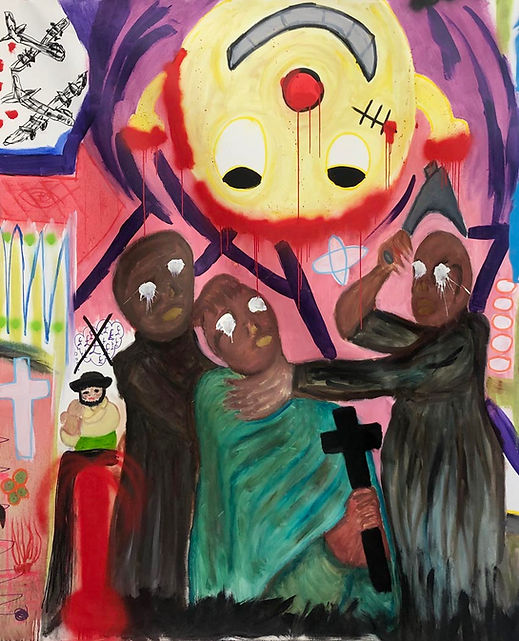
From War With Love: Chapter II, mixed media on canvas, 215 x 130 cm, 2019.
In this painting three robed male figures represent religious violence. Their robes resemble vestments associated with liturgy. But there are also satirical elements in the composition. The upside-down bleeding smiley represents religious farce, aeroplanes dropping bombs highlight the role that religion has played in many wars, and a phallus represents the power that has been held by mostly men in organised religion. The Portuguese figure of Zé Povinho here symbolises religious hypocrisy around money.

From War With Love: Chapter III, mixed media on canvas, 215 x 140 cm, 2019.
This section represents male aggression expressed in war. The gremlin-like male figures with big penises representing their big “weapons.” Then in opposition to these figures a female figure stands in profile with exaggerated features such as a big ass, reminiscent of fertility figurines and representing a female image currently idealised by the likes of Kim Kardashian. The intention here is to represent exaggerations of both male and female body images and how they can represent symbolic power/violence. Gender dominance, for example, is a form of symbolic power. But this image has another meaning related to war and it also represents how rape is used as a weapon in war.
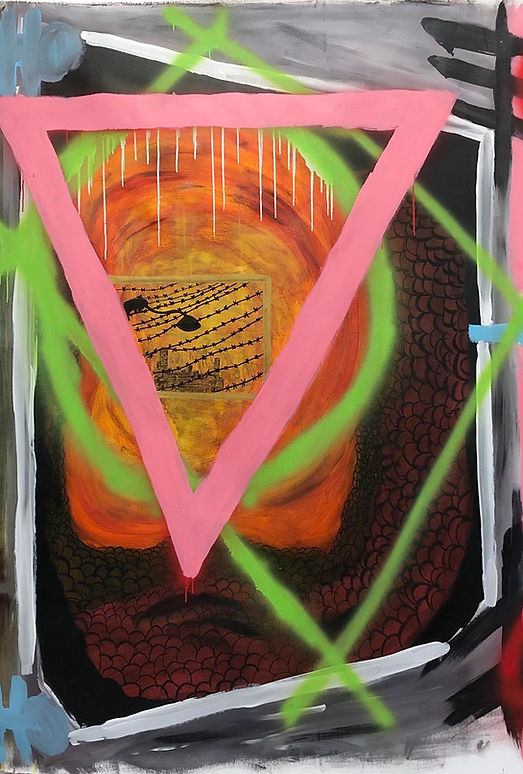
From War With Love: Chapter IV, mixed media on canvas, 215 x 120 cm, 2019.
This composition is based on two photographs that I took in Auschwitz (the barbed wire of the fences around the concentration camp and the chimneys of the gas chambers). It represents the violence perpetrated against minorities and those perceived as “other”. I added several abstract shapes and lines representing frames within frames to represent hidden narratives and I spray painted an inverted pink triangle as a frame to depict the badge that the Nazis used to identify sexual minorities in concentration camps. When painting this imagery I was conscious of wanting to challenge the idea of some subject matters being unrepresentable.
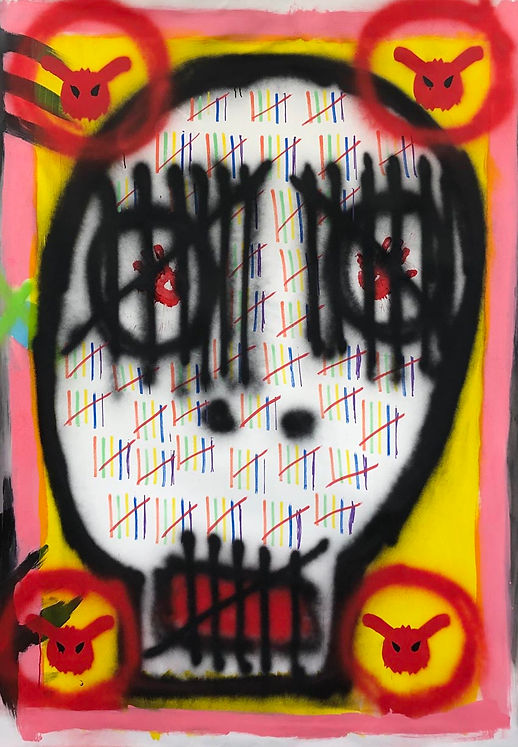
From War With Love: Chapter V, mixed media on canvas, 215 x 120 cm, 2019.
In this section a flat skull has inside tally marks drawn using the colours of the LGBTQI+ flag as a form of symbolising the numbers of LGBTQI+ people murdered in the world. The red hands inside the eyes of the skulls (stamped with my hands painted red) represent the bloody hands of the murderers. Spray painted faces on each corner of the skull composition with phallic shaped ears depict male dominant thinking associated with conflict and war. Skulls are associated with transgression, but also with danger and death. The skull and crossbones symbol has also traditionally been associated with warfare, and it was a feature of uniforms worn by Nazi SS officers in Germany.
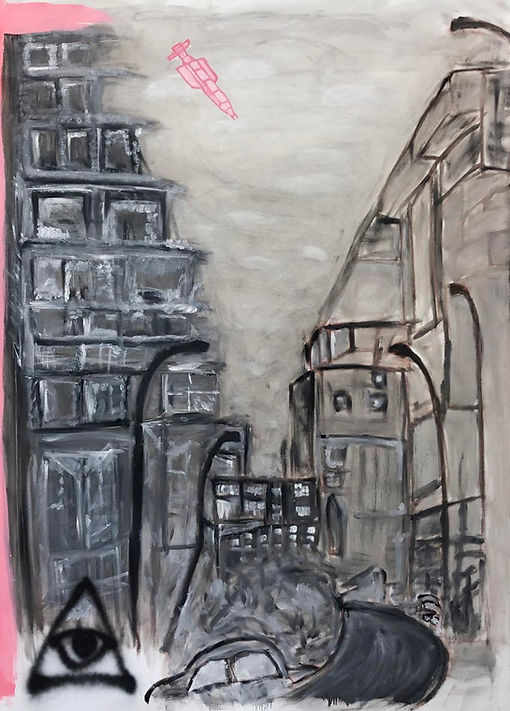
From War With Love: Chapter VI, mixed media on canvas, 215 x 120 cm, 2019.
This section represents the destruction of communities during war. It is based on photos that I have recently seen of destroyed Syrian towns. I added the image of a pink bomb based on the model of the American Massive Ordnance Air Blast (MOAB - commonly known as ‘Mother of All Bombs’), first dropped in combat in 2017. I painted the bomb pink as a subversive commentary of war in that whilst pink is associated with cuteness and the idea of the feminine; most wars are started by men. The last part of the painting is left looking unfinished as a way of representing how history continues, open-ended.

From War With Love, mixed media on canvas, 215 x 1000 cm, 2019.
The scroll painting is meant to be exhibited hanging in a circle. As I also wanted the inside of the circle to be experienced by the viewer, I thought further about the subject matter that I painted and about a possible title for the painting. The title came ‘From War With Love’, as I associated the frame in the image that I painted of the concentration camps with a postcard. I then associated the image with the fact that sites of war (including concentration camps) became tourist destinations and tourists do write postcards home from places that they visit. If in remembrance one can visit places of such war atrocities why can’t one paint them as a similar gesture?

From War With Love (reverse), mixed media on canvas, 215 x 1000 cm, 2019.
Following on from the thought of people writing home from places of war, I thought of adding another layer of meaning to the piece by writing extracts of letters written by fallen soldiers to their loved ones, representing the paradoxes involved in war - love for one’s nation and ideology versus hatred towards the Other. I also stencilled, using spray paint and a net, gestural marks as ‘impressions’, depicting the shadows that were etched on surfaces when the world’s first atom bomb exploded in Hiroshima on 6 August 1945. It is believed that the heat from the explosion was so intense that it bleached the buildings and the ground in the blast zone, leaving behind the shadows of anything in its path. I used a net as a way of symbolising human skin.
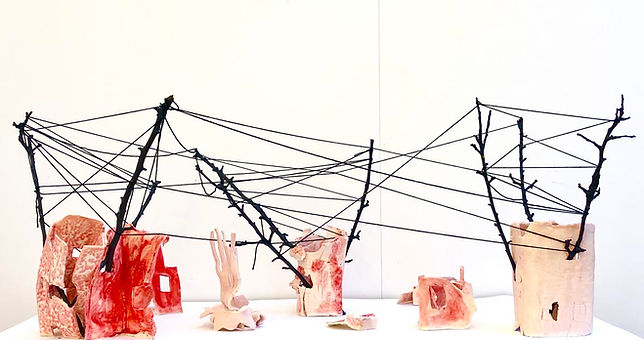
From War With Love, glazed porcelain, wood and wool yarn, 2019.
The porcelain objects symbolise buildings and communities destroyed in war. I experimented with different glazes and settled for pink and red glazes that resemble flesh and skin as a way of representing the wounds of war, but also to appear as if the buildings also resembled dismembered bodies. I then added blackened oak sticks and connected the structures with black wool yarn representing lines of mourning.
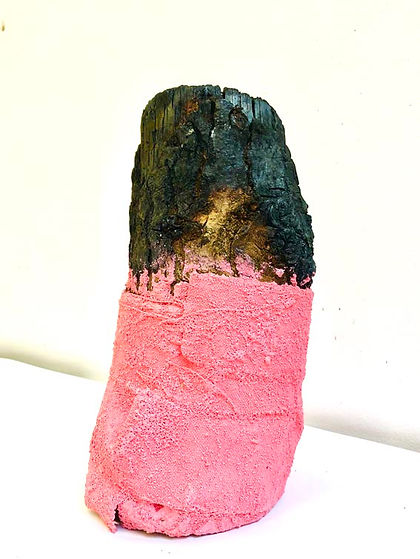
From War With Love, wood, canvas and acrylic, 2019.
The burnt log symbolises destruction of nature during conflict. I partially wrapped it with a strip of canvas painted pink as a way of subversively deconstructing the dichotomy between perceived masculinity and femininity, power and submission, destruction and peace.